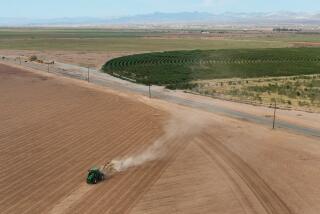El Nino Might Create Only a Peep
- Share via
With an official pronouncement titled “He’s baaack!” government climate forecasters declared Thursday that El Nino had officially returned--although in a weaker than normal state.
Several consecutive months of slightly higher temperatures and heavier than usual rainfall in South America led the National Oceanic and Atmospheric Administration’s Climate Prediction Center to make its announcement, even though some leading scientists are still skeptical.
Vernon Kousky, a NOAA meteorologist and climate specialist, agreed that the current pattern is not a classic one but said it does meet a technical definition for El Nino developed by the administration.
“This time around, El Nino will not be as powerful as the 1997-98 event, but we’ll track it closely for any change in its projected strength,” he said.
Bill Patzert, a satellite oceanographer at the Jet Propulsion Laboratory in Pasadena who tracks the temperature of Pacific waters, said it still seems too early to conclude that a messy, stormy El Nino season is heading toward California. “He’s baaack? They’re making it sound like a poltergeist. It’s more like one of the seven dwarfs,” he said.
Patzert, who has taken to referring to the weather system as “El No Show,” said that ocean temperatures are only about 1.8 degrees above normal, not the 5.4 to 9 degrees of added warmth that accompany a “whopper” El Nino.
“It’s a little warmer at the equator than it was a year ago,” Patzert said. “Whether that evolves into a full-blown El Nino, no one knows.”
NOAA forecasters have been predicting for months that a weak El Nino would develop. But the classic pattern--a dramatic ocean and atmospheric disruption that sends warm water surging across the equatorial Pacific toward South America to disrupt fisheries and alter global weather patterns--had never materialized.
Government weather forecasters said the system could “mature” and lead to warmer, wetter weather in California this fall. El Nino systems normally serve to suppress Atlantic hurricanes, but Kousky said the system developing now is probably too weak to do so.
The system is so weak now that Patzert questioned the point of even making an announcement. Large El Nino patterns usually develop in the winter, and only rarely in the summer, he added.
“You could have a late-summer-developing El Nino, but then the impacts don’t hit us until December or January, so what’s the sense of screaming fire in a theater?” Patzert said.
Even if the temperature changes in the Pacific Ocean do develop into what a majority of scientists consider an El Nino system, Patzert said, it may not bring California any rain. In the past, he said, small El Nino systems have led to very dry years in California. “They’re not all a repeat of ’97 and ‘98,” Patzert said.
“I’d hold off on fixing my roof and clear away brush from the house,” he said. “Our main problem right now is drought.”






